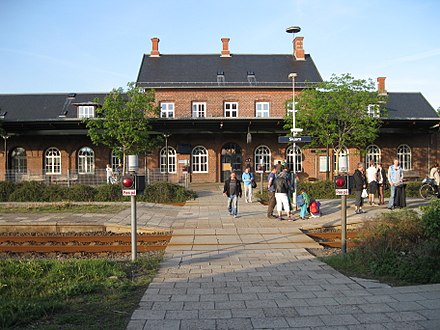Skjern, Denmark
Skjern | |
|---|---|
Town | |
 Skjern railway station | |
| Coordinates: 55°56′52″N 08°29′48″E / 55.94778°N 8.49667°E / 55.94778; 8.49667 | |
| Country | Denmark |
| Region | Region Midtjylland |
| Municipality | Ringkøbing-Skjern |
| Area | |
| • Urban | 6.9 km2 (2.7 sq mi) |
| Population (2023)[1] | |
| • Urban | 7,840 |
| • Urban density | 1,100/km2 (2,900/sq mi) |
| • Gender [2] | 3,866 males and 3,974 females |
| Time zone | UTC+1 (CET) |
| • Summer (DST) | UTC+2 (CEST) |
| Postal code | DK-6900 Skjern |
Skjern is a railway town just north of the Skjern river in western Jutland, Denmark with a population of 7,840 (1 January 2023).[1] The town was the seat of the former Skjern Municipality, though since 2007 it has been the joint administrative seat of Ringkøbing-Skjern Municipality.
The town's expansion in the 19th century was the result of the newly created Skjern railway station. Today, it is connected to the Esbjerg–Struer line and the Skanderborg–Skjern line.[3] It is also served by the Stauning Vestjylland Airport, which also contains Danmarks Flymuseum, displaying historic aircraft.
History
According to legend, King John was thrown from his horse in the ford crossing Skjern river in 1513. He died on 20 February of that year, most likely from pneumonia as a result of the lake's cold water.
In 1875, the a station on the Esbjerg–Struer railway line opened in Skjern. The town then became the site of a railway junction in 1881 when the Skanderborg–Skjern line opened. The town grew rapidly as a result of the railway traffic. In 1879 it consisted of a church and parsonage, school, inn, general store, and a smattering of farms and houses.[4] By 1904, the town had more than 1120 inhabitants, as well as several schools, mission houses, banks, hotels, and industrial works.[5] In the mid 20th century, the town's economy was primarily based upon industrial work. According to the 1930 census, of Skjern's 2,985 residents, 94 worked in agriculture, 1146 in industry, 424 in trade, 496 in transportation, and 298 in housework.[6]
For a short period around 1940, Skern was the common spelling used for the town.[7] In 1958, the town was designated as a market town (Danish: købstad), though the designation lost its official significance in the 1970 municipal reforms. Through the reforms, Skjern became the seat of the newly formed Skjern Municipality which included the parishes of Bølling, Dejbjerg, Faster, Hanning, Skjern, Stauning, Sædding, and Sønder Borris. The municipality has since been merged to form Ringkøbing-Skjern Municipality.

A statue of Holger Danske by Hans Peder Pedersen-Dan was moved to Skjern in 2013 from the Hotel Marienlyst in Helsingør after it was sold on an auction site.[8][9] The statue is now a tourist attraction in Skjern.
Popular culture
Skjern is the home town of the player character in the computer roleplaying game Expeditions: Viking.
Notable people
- Martin Borch (1852 at Skerngaard near Skjern – 1937) a Danish architect
- Egon Hansen (born 1931 in Skjern) a Danish former sports shooter, competed in the 1972 Summer Olympics
- Gnags (formed 1966 in Skjern) a Danish rock band formed by brothers Peter & Jens Nielsen
- Kristian Gjessing (born 1978 in Skjern) a Danish retired handball player, played for Skjern Håndbold and for Denmark
- Marianne Bonde (born 1984 in Skjern) a Danish retired handball player, played for Slagelse DT and for Denmark
- Trine Troelsen (born 1985 in Skjern) a Danish retired handball player, played for FC Midtjylland Håndbold and for Denmark
- Kasper Søndergaard (born in 1981 in Skjern) a Danish retired Handball player, played for Skjern Håndbold and for Denmark
- Mathias Gidsel (born in 1999 in Skjern) a Danish handball player, player for GOG Håndbold, Füchse Berlin and for Denmark
See also
- Skjern railway station
- Skjern River
- Skjern Håndbold, a handball club from Skjern
References
- ^ a b BY3: Population 1. January by rural and urban areas, area and population density The Mobile Statbank from Statistics Denmark
- ^ BY1: Population 1. January by urban areas, age and sex The Mobile Statbank from Statistics Denmark
- ^ "Skjern Station" (in Danish). Arriva. Retrieved 10 May 2021.
- ^ Trap, J.P., ed. (1879). "Stjern Sogn". Kongeriget Danmark (in Danish). Vol. VI (2nd ed.). p. 408.
- ^ Trap, J.P., ed. (1904). "Skjern Sogn". Kongeriget Danmark (in Danish). Vol. V (3rd ed.). Copenhagen: G.E.C. Gad.
- ^ Statistisk Tabelværk (in Danish). 1935. p. 158.
- ^ Gregersen, A. (1974). "Nedlagte Baner: Jyske Statsbanestrækninger" (PDF). Signalposten (in Danish). 5: 200.
- ^ Brovall, Sandra (6 May 2014). "Nu sover Holger Danske i Skjern". Politiken (in Danish).
- ^ Nielsen, Jesper (26 April 2013). "Holger Danske solgt: Her ender han". TV 2 (in Danish).

